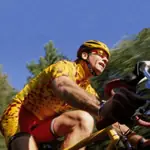
"Who the hell is this guy, Ian Jackson?"
That was the way one of my fellow competitors characterized his intimidation before the start of the first Big Island Ironman triathlon back in 1981. Jackson had announced his confidence of an overall win in the press, and given the infantile level of the sport back then, nearly everyone could be considered a threat. Because we were worlds apart, I was intrigued with his creative approach.
Like most of the competitors, I was submerged in the physical prowess of the sport while Jackson dealt in the metaphysical and sublime. At first, I thought I had the edge when I actually won the event and Ian finished well back in the field. It was much later on the bike—the strongest element of my multi-sport career—that I came to realize I had only scratched the surface of what human performance really means.
More: How to Control Your Breathing in Competition
The highpoint of Ian Jackson's notoriety came after the 1984 Olympic Road Race when Alexi Grewal became the first American to win the Gold medal. Grewal, who had worked with Jackson before the games, called Jackson's work, "The most powerful tool that can be imagined." The original name Jackson gave to his technique was BreathPlay, a well documented but seldom understood technique that emphasizes the out-breath.
BreathPlay makes breathing easier and more efficient. Among the research that supports the principles of BreathPlay, which Jackson would eventually call "Zooming," is Daniel Wojta's study of 25 top cyclists at the University of Toledo. Wojta found that those riders who used BreathPlay significantly increased endurance and improved aerobic capacity by more than 17 percent. BreathPlay flips the active and passive phases of breathing upside down. As Jackson used to explain, "Instead of just sucking in and letting it out, try pushing the air out then let it back in."
When I had the opportunity to work with Jackson at the Baylor School in Tennessee, he explained to me that I needed to set up a breathing pattern which would vary based on the intensity of the activity. "When you breathe," I remember him saying, "Flatten your stomach as you breathe out. Time your breaths around your pedal stroke. The rhythm that follows is always odd-numbered, three out, followed by two in." On longer tempo climbs I found the two-out, one-in pattern worked best for me.
More: Breathing 101: Increase Your Efficiency
While he was working with Wojta, Jackson was also teaching the technique to the USA Cycling Team. USA took 10 riders for control and measured their actual VO2 max, heart rate, blood pressure and perceived exertion. At the completion of a 10-day test, they repeated the same protocol using BreathPlay. The results showed the cyclists increased their endurance by more than 7 percent.
While this early test did not include actual power testing, it was noted that the 10 cyclists delayed the onset of anaerobic metabolism (the point where the body can no longer get enough oxygen from breathing and begins to use stored energy in the muscles) by 17-25 percent. Those who took the test found the BreathPlay version of the test easier to perform.
More: 3 Exercises to Increase Your Lung Power
How It Works
According to Wojta, when you are exercising you use a lot of energy just to get air. By making a conscious effort to control your breathing, the BreathPlay group breathed much more efficiently at maximum workout effort. Jackson taught BreathPlay techniques to a number of athletes, myself included, back in the 1980s.
- 1
- of
- 2
Get ACTIVE on the Go


Meet Mobile
Swim smarter: heats, lane assignments and real-time results in the palm of your hand.
Available for iOS | Android







Discuss This Article